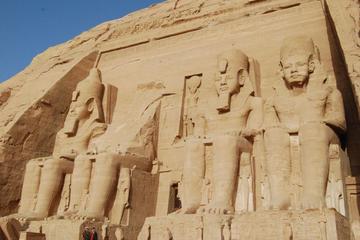
The two temples at Abu Simbel are perhaps the best known and most visited ancient sites in Egypt after the Pyramids of Giza. Built by Ramesses II in the 13th century BC to commemorate himself and his wife Nefertiti, the temples are huge stone monuments. They sit on the banks of Lake Nasser, about 180 miles (290 kilometers) southwest of Aswan. In the 1960s, when the area was to be flooded by the construction of the Aswan High Dam and Lake Nasser, the temples were literally cut into pieces and moved to higher ground where we see them today. They are that culturally significant, and are today part of a UNESCO World Heritage Site known as 'Nubian Monuments.'
There is a daily light and sound show at the temple which is impressive if a little high-tech and non-ancient. More naturally, the sun shines directly onto the sculpted face of Ramesses II on February 22 and October 22, his birthday and day of coronation.
The temples lie southwest of Aswan. There are many organized tours going there from Aswan, and daily buses. They all leave around 3am to catch the morning sun on the temple and avoid the heat - the trip is about 3 hours each way and make sure you get one with air conditioning. The buses travel in military-protected convoy - do not drive there on your own. You can also take a plane from either Cairo or Aswan (30 minutes) or, if you have more time, take a boat down the Nile and approach the temples in a more traditional way (a 5-day round trip stopping at other temples).